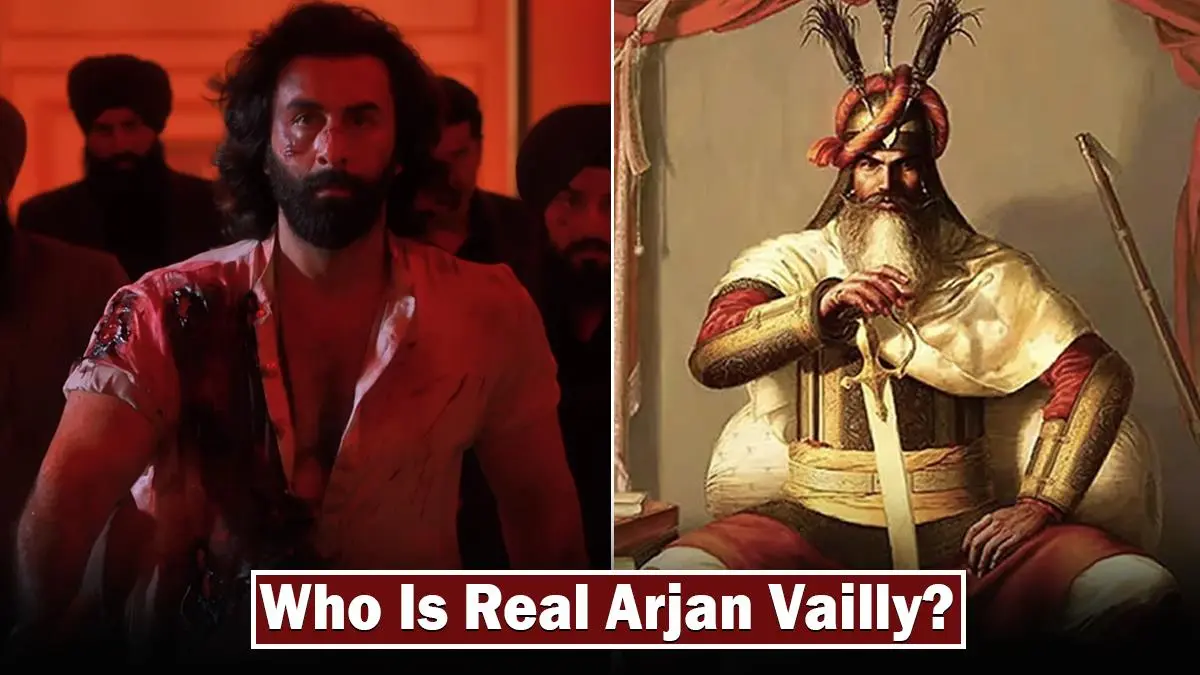Animal, directed by Sandeep Reddy Vanga, has ignited a firestorm of conversation since its release. The film’s electrifying action sequences, coupled with the captivating performances of its talented cast, have left audiences buzzing with excitement and anticipation for its next chapter.
Leading the charge is Ranbir Kapoor, delivering a performance that is both nuanced and explosive. He portrays a character on a complex journey, grappling with internal turmoil while navigating a world of violence and retribution. Kapoor injects each scene with raw emotion and intensity, drawing viewers into the depths of his character’s psyche.
The song “Arjan Vailly” has been making waves, not only for its powerful music and Ranbir Kapoor’s captivating performance, but also for its intriguing lyrics and historical background. Let’s delve into the story behind this song and unpack its hidden meaning.
Also Read: Ranbir Kapoor shoots for a special cameo for Aryan Khan’s web series
Arjan Vailly: A Warrior of the Sikh Empire
Early Life and Family:
Arjan Vailly, also known as Arjan Singh Nalva or Arjan “Vailly,” was born into a family deeply intertwined with the history of the Sikh Khalsa Fauj. Hailing from the Malwa region in southern Punjab, his origins trace back to the village of Kaunke, near present-day Ludhiana.
As the youngest son of Hari Singh Nalva, the renowned Commander-in-Chief of the Sikh Khalsa Fauj, Arjan inherited a legacy of bravery and military prowess. His father, famously known as Baghmaari, played a pivotal role in expanding the boundaries of the Sikh Empire, stretching its reach beyond the Indus River and into present-day Afghanistan.
Military Service and Defending the Sikh State:
Under the patronage of Kanvar Nau Nihal Singh, the grandson of Maharaja Ranjit Singh, Arjan Vailly actively participated in safeguarding the sovereignty of the Sikh State. As tensions escalated with the encroaching British forces in the run-up to the Second Anglo-Sikh War, he joined the Sikh army in their resistance.
The Battle of Gujranwala and Beyond:
Despite the British siege of his fortified house in Gujranwala, Arjan Vailly skillfully managed to evade capture, showcasing his strategic brilliance and resilience. His bravery and resistance against the British solidified his image as a courageous warrior committed to the defense of his homeland.
A Legacy of Valor:
Arjan Vailly’s story serves as a testament to the unwavering spirit and dedication of the Sikh warriors. His life exemplifies the importance of courage, loyalty, and unwavering dedication in the face of adversity. His legacy continues to inspire generations and serves as an enduring reminder of the sacrifices made in the pursuit of freedom and justice.
Rooted in Tradition:
Composed in the Dhadi-Vaar music style, “Arjan Vailly” echoes the war cries used by Guru Gobind Singh to inspire his people during battles against the Mughals. Originally sung by the legendary Kuldeep Manak, the song draws inspiration from the life and valor of Arjan Singh Nalwa, also known as “Arjan Vailly.”
Hero of the Sikh Empire:
Arjan Singh Nalwa, son of the renowned warrior Hari Singh Nalwa, played a pivotal role in safeguarding the sovereignty of the Sikh State. Following his father’s death, he, along with his brother Jawahir Singh Nalwa, fiercely resisted the encroaching British expansionism.
Decoding the Lyrics:
The song’s opening line,
“Ho Khade Vich Dang Khadke, Othe Ho Gayi Ladayi Bhari,”
sets the scene of a fierce battle unfolding amidst the crowd. The iconic line,
“Arjan Vailly ne Pair Jod Ke Gandasi Maari,”
translates to “Arjan Vailly hit the axe with full force, joining his feet together.” This imagery depicts the warrior’s unwavering determination and powerful attack.
Further lyrics paint a vivid picture of the chaotic battle:
“Takuye gandanse chaviya Kehte khadak paiyan kirpana”
– All weapons, including the Kirpan, were used with fierce intensity.
“Oh Sana Wangu Jatt Bhirhde, Sakhi Sukh Na Disse Bhagwana”
– The Jatts fought like raging bulls, leaving no room for peace.
“O Leero Leer Ho Jaugi, Kehnde Bachno Di Phulkari”
– The fight’s intensity threatened to tear apart even the belongings of the innocent.
Lionhearted Bravery:
The song compares the warriors to lions, highlighting their courage and strength. Lines like
“Mundiyan De Singg Fass Gaye, Ve Koi Nitroo Vadenve Khani” and
“Sher jeha rohb jatt da Thalle rakh da police sarkaari”
Emphasize their fearlessness and dominance.
A Deeper Connection:
“Arjan Vailly” transcends its portrayal of warfare and delves into the father-son bond. Ranbir Kapoor’s character, depicted with an axe in hand and a bloodied shirt, embodies the unwavering spirit of Arjan Vailly, seemingly carrying out his father’s will.
A Legacy Remembered:
The song serves as a powerful tribute to the valor of the Nalwa family and their significant contributions to the Sikh Empire. It reminds us of the importance of courage, loyalty, and unwavering dedication in the face of adversity.
By understanding the story and meaning behind “Arjan Vailly,” we gain a deeper appreciation for its historical significance and emotional impact, making it more than just a catchy song. It becomes a testament to the enduring legacy of bravery and sacrifice.
About Animal Movie:
Sandeep Reddy Vanga’s ‘Animal’ dives deep into a tense father-son relationship set against the gritty backdrop of the underworld. Starring Ranbir Kapoor, Bobby Deol, Anil Kapoor, Rashmika Mandanna, and Triptii Dimri, the film has gained praise, boasting a solid IMDb rating of 7.4/10 and an impressive 84% audience score on Rotten Tomatoes. Released globally on December 1 alongside Vicky Kaushal’s ‘Sam Bahadur,’ ‘Animal’ roared at the box office, raking in a massive 63.80 crore on its opening day. Surpassing the first-day earnings of major hits like Tiger 3, Pathaan, and Gadar, Ranbir Kapoor’s ‘Animal’ proved its mettle as a dominant force in cinema right from the start.
Also Read: Bollywood Bosses: 7 Celebrities Ruling Both Stage and Business
To Get more such updates and crucial information stay in touch with The Digital Today.

